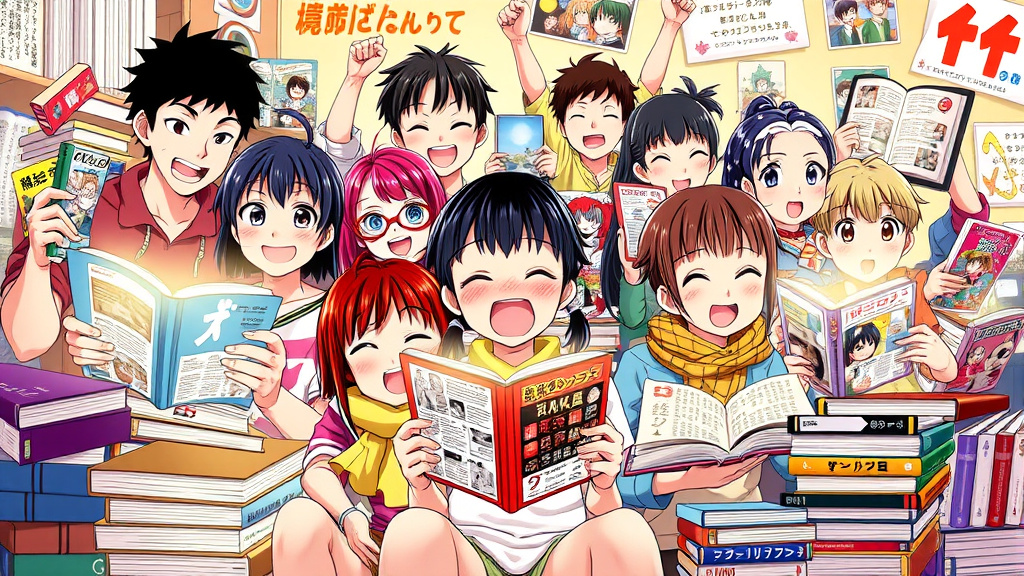When it comes to experiencing manga, many aficionados cherish the tactile pleasure of flipping through pages of a manga paperback. These physical editions are more than just stories on paper; they are collectible artifacts, artistic showcases, and a bridge connecting readers to manga culture across generations. The manga paperback format continues to hold a special place in the hearts of fans worldwide, blending accessibility with aesthetic appeal and nostalgic value.
The Enduring Appeal of Manga Paperbacks
The timeless appeal of manga paperbacks lies in their tangible presence—a physical embodiment of visual storytelling that digital media can hardly replace. Unlike digital versions, paperbacks allow readers to hold a piece of manga history, turn over pages at their own pace, and cherish the cover artwork and intrinsic design details that often reflect the essence of the story within. This sensory experience fosters a deeper emotional connection, turning casual reading into a cherished ritual.
Moreover, manga paperbacks serve as cultural artifacts, representing specific eras and publishing trends that reveal the evolution of manga art and storytelling. They often feature iconic cover art, unique spine designs, and high-quality printing that elevate them from mere reading material to collectible treasures. The enduring popularity of these formats is a testament to their ability to transcend digital convenience and foster a sense of ownership, pride, and nostalgia among fans of all ages.
 Hình minh họa: manga paperback – read manga for free reddit
Hình minh họa: manga paperback – read manga for free redditCollecting Manga: A Guide to Paperback Editions
Collecting manga paperbacks can be a rewarding venture, blending the thrill of discovery with the satisfaction of curating a personal library. Start by identifying your favorite series or genres—whether it’s shonen, shojo, seinen, or horror—then focus on acquiring editions that are well-preserved and genuine. Pay attention to publication details such as release dates, publisher marks, and editions to ensure authenticity, especially when hunting for rare or out-of-print copies.
A good collector’s practice involves tracking variations like hardcover editions, special reprints, and international releases. Some manga series become highly sought after when specific volumes go out of print, making them valuable over time. Building a collection also involves immersing yourself in communities of collectors and dealers to get insights, trading opportunities, and alerts about rare finds. Ultimately, collecting manga paperbacks becomes a personal journey—each volume telling a story beyond its pages, reflecting your tastes and dedication as a fan.

Manga Paperback Formats: Sizes, Binding, and Pricing
Manga paperbacks come in a variety of formats that influence both aesthetic appeal and affordability. The most common size is the standard Japanese manga size, approximately 5 x 7.5 inches, offering a compact and portable format that fits comfortably in one hand. However, some editions, especially hardcover or deluxe versions, are larger, emphasizing artwork and making for striking display pieces.
Binding options also vary—traditional perfect-bound paperbacks are prevalent, but special editions might feature sewn binding or hardcover options for durability and presentation. Pricing can fluctuate greatly depending on factors such as publisher, rarity, print run, and condition. Standard editions are quite affordable, making manga accessible, while collector’s editions or out-of-print volumes can command premium prices on the secondary market. Understanding these variations helps fans make informed decisions about building their collection and investing in editions that suit their aesthetic and budget preferences.
Preserving Your Paperback Manga Collection: Tips and Best Practices
Maintaining the condition of manga paperbacks is essential for preserving their value and appeal over time. Store your collection in a cool, dry environment away from direct sunlight, which can cause fading and warping. Use protective covers or sleeves to prevent dust, fingerprints, or accidental tears—especially for rare or vintage copies. Proper shelving that supports the spines without bending or warping is equally important, with upright storage preferred over stacking to avoid undue pressure.
Handling manga carefully is a fundamental part of preservation. Always wash your hands before browsing your collection to minimize oils and dirt, and avoid excessive bending of pages to prevent tears and creases. When possible, keep manga in acid-free boxes or archival-quality sleeves for long-term storage, especially if you own valuable editions. Regular inspection and gentle cleaning can help identify early signs of deterioration, ensuring that your manga collection remains pristine for years to come.
Paperback Manga vs. Digital: Pros and Cons for Readers
The debate between physical manga paperbacks and digital copies hinges on personal preferences and practicality. Paperback manga offers a tactile experience—turning pages, appreciating cover art, and physically owning a piece of manga culture that digital formats cannot replicate. Many fans find joy in collecting, displaying, and flipping through physical books, which can evoke nostalgia and a sense of personal connection.
Conversely, digital manga provides unparalleled convenience—instant access to vast libraries, portability for reading on the go, and often lower costs. Digital editions also tend to be more environmentally friendly by reducing paper waste. However, some argue that the digital format lacks the sensory and collectible value of paperbacks and can feel less immersive. Ultimately, choosing between the two depends on whether your priority is the experience of physical media or the practicality and breadth of digital access. Many dedicated fans opt for a hybrid approach—owning physical copies of favorites while enjoying digital titles for convenience and variety.
The Evolution of Manga Paperback Design
Manga paperback design has undergone significant transformations, reflecting shifts in art styles, publishing technology, and market trends. Early manga editions often featured minimalist covers, highlighting character art or logo designs, but contemporary paperbacks tend to embrace vibrant, detailed artwork with dynamic typography to attract readers. Innovations in printing technology have allowed for richer color reproduction, sharper images, and higher-quality paper, elevating the aesthetic quality of manga paperbacks.
Design trends also mirror cultural changes—japanese publishers occasionally release special editions with slipcases, art books, or hardcover variants that appeal to collectors and fans seeking premium presentations. The evolution of design has also responded to global markets, with Western publishers adopting distinct styling cues to bridge cultural gaps. Overall, manga paperback design continues to evolve, blending artistry, market demands, and technological advances to create editions that are both inviting and collectible.
Finding Rare and Out-of-Print Manga Paperbacks
Locating rare or out-of-print manga paperbacks can be a thrilling yet challenging quest. These editions often become sought-after due to their limited print runs, unique cover art, or significance in manga history. To find these gems, persistent searching through online marketplaces, specialized comic book stores, and collector communities is crucial. Platforms like eBay, AbeBooks, and dedicated manga collector forums can be treasure troves for rare editions, especially when sellers provide detailed condition descriptions and provenance.
Building relationships within collector communities, attending conventions, and participating in swap meets can increase the chances of discovering out-of-print or vintage manga paperbacks. Patience and diligent monitoring are key—sometimes, a sought-after volume appears unexpectedly, valuing the collector’s persistence. Procuring rare manga editions not only enriches a collection but also offers a tangible link to manga’s history and evolution—treasures that often prove to be valuable investments over time.
The Resurgence of Physical Media: Why Manga Paperbacks Still Matter
Despite the rising dominance of digital media, there is a noticeable resurgence of interest in physical manga paperbacks. This trend can be attributed to a desire for a more immersive, collectible experience that digital formats cannot fully replicate. For many fans, owning a well-designed manga paperback feels more personal and meaningful—each edition represents a milestone in their manga journey, an artifact that can be treasured, shared, and passed down.
Additionally, the nostalgia associated with flipping through paper pages and the desire to support local bookstores and publishers maintain the relevance of manga paperbacks. They serve as a physical connection to art, culture, and storytelling that transcends fleeting digital access. This revival underscores the idea that physical media offers an enduring value—assembling a personal library, appreciating artwork, and embracing the original essence of manga culture. Many publishers are responding by releasing special editions or high-quality collections, reinforcing that manga paperbacks continue to be vital in the digital age.
Paperback Manga for Beginners: Where to Start Your Collection
For newcomers eager to dive into manga, starting with paperback editions provides an accessible and engaging entry point. It is wise to choose popular or critically acclaimed series known for their quality storytelling and artwork. Classics like Naruto, One Piece, or Attack on Titan often have multiple paperback editions available at an affordable price, making them ideal for building a foundational collection. Visiting local bookstores or online retailers can help beginners find accessible options that are both affordable and inviting.
Building a collection as a beginner involves balancing personal interests with diversity—exploring different genres, art styles, and publishers helps develop a well-rounded taste and appreciation for manga. Embracing the tactile experience of owning physical copies encourages a deeper connection to the stories, artists, and culture behind the works. Ultimately, starting with a core collection of well-preserved manga paperbacks sets the stage for a lifelong journey of discovering new series, appreciating collectible editions, and celebrating manga culture in its physical form.
Exploring Different Genres Through Paperback Manga
One of the enchanting aspects of manga paperbacks is their breadth across genres, offering something for every reader. From action-packed shonen stories to emotional shojo romances, and from dark seinen narratives to niche genres like horror or fantasy, paperback editions make exploring these worlds accessible and tangible. The physical format often highlights genre-specific design elements—dynamic covers for action titles, delicate artwork for romance, or gritty, textured covers for horror—that enhance the reading experience.
Diving into various genres through paperback manga allows readers to immerse themselves in cultural nuances, artistic styles, and storytelling conventions unique to each category. The collectible nature of paperback editions encourages readers to seek out rare or out-of-print volumes across genres, broadening their understanding and appreciation of manga’s diversity. Exploring these genres in physical form enriches the sensory and aesthetic experience of manga, transforming reading into an engaging voyage through different worlds, art styles, and cultural perspectives.
## Conclusion
In summary, manga paperbacks remain a vital and cherished aspect of manga culture, offering aesthetic beauty, tactile pleasure, and collectible value that digital formats alone cannot fully provide. Their timeless appeal is rooted in emotional connection, artistic expression, and their role as cultural artifacts that reflect the evolution of manga over decades. Collecting manga paperbacks involves thoughtful curation, preservation efforts, and a passion for discovering rare editions that can become treasured possessions. As the manga industry continues to evolve, the physical format’s enduring relevance is reinforced by the unique, immersive experience it offers—an experience that resonates deeply with fans, both new and old. Whether you're just starting your collection or seeking to deepen your appreciation, manga paperbacks remain an essential gateway into the captivating world of manga art and storytelling.





:max_bytes(150000):strip_icc()/1_LiveGivePlay_Spiritos_79King_byBKSKArchitects_sm-44c86eeae3b440cd8afaa91d230363d6.jpg)